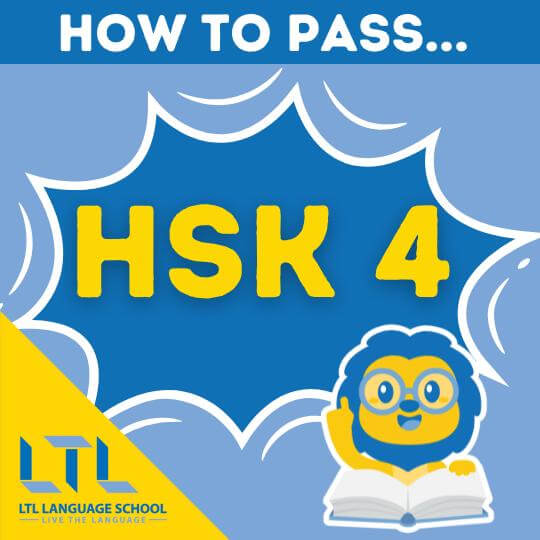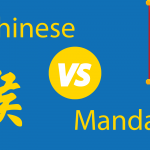How To Pass The HSK 4 With Style // Top Tips & Tricks (for 2025)
How to Pass the HSK 3 | How to Pass the HSK 5
Today we provide you with an ultimate guide on how to pass the HSK 4, complete with tips, tricks and hugely useful pointers.

The HSK 4 exam is a major milestone in the learning journey of any serious Chinese language student.
While the HSK 1-3 tests certify modest knowledge of the language, the HSK 4 is the first exam that can show working proficiency in the Chinese language.
According to Hanban, an HSK 4 certificate is equivalent to a CEFR B2 certificate, which shows conversational ability in the language.
A HSK 4 certificate can be good enough for many university programs and may be good enough for undergraduate and even graduate degrees entirely in Chinese.
As such, passing the HSK 4 exam is no small feat. Learning all the vocabulary and grammar structures needed to pass the HSK 4 will take a lot of time, dedication, and effort.
Regardless, thousands of students pass the HSK 4 exam every year, and there is no reason you shouldn’t be one of them.
This guide will walk you through the HSK 4 exam structure and show you how to pass the HSK 4. If you are interested in learning new study strategies and HSK tips, this guide is for you!
How to Pass HSK 4 | Understand the Structure of HSK 4
How to Pass HSK 4 | Study & Learn the HSK 4 Content
How to Pass HSK 4 | Utilise Books
How to Pass HSK 4 | Test Your Vocabulary
How to Pass HSK 4 | Work On Your Listening
How to Pass HSK 4 | Work On Your Reading
How to Pass HSK 4 | Take Full Length Tests
How to Pass HSK 4 | FAQs
How to Pass HSK 4 | Understand the Structure of HSK 4
Paper vs Internet
The very first step in preparing for the HSK 4 test is to understand the test structure. This is particularly true if you have taken any of the HSK 1-3 tests since this test will have some key differences.
Much like the HSK 1-3 exams, the HSK 4 is offered in two different versions: paper-based and internet-based.
These two versions have identical sections, and the difficulty of the questions is the same.
The main difference between the paper-based and the internet-based test is that handwriting characters are necessary for the paper-based version of the HSK 4.
This can be very time-consuming and hard to learn for most Chinese students, so we usually recommend all students to take the internet-based exam instead.
With the internet-based test, students can use their keyboards to type characters by using pinyin. This makes it not only much easier to write but also significantly faster.
The HSK 4 exam does not take into account the time difference between handwriting and typing characters. The paper-based test is five minutes longer (105 minutes as opposed to 100 minutes), but that accounts for the time spent entering answers into the answer sheet.
Thus, most students will be much better off taking the internet-based option instead of the paper-based as they will have more time to get through each question.
Besides handwriting, both versions of the test come in identical formats.
HSK 4 Sections
The HSK 4 is composed of three major sections:
- Listening
- Reading
- Writing
Doing well in all three sections can maximize your chances of passing the test, so it’s important to be familiar with each of the sections and prepare accordingly.
Here is a breakdown of each of the three sections of the HSK 4 and the kinds of questions you will encounter.
Listening | HSK 4
The listening section will always be the first section of all HSK 4 exams.
The listening section of the HSK 4 is 30 minutes long and consists of three parts with a total of 45 questions.
TOP TIP | Unlike with previous levels of the HSK, the audio in the listening section of the HSK 4 will only be played once.
Part I of the listening section consists of 10 monologues. After listening to each monologue, the student will listen to a statement (which will also appear on the screen or paper) and determine if the statement is true or false based on the monologue.

Part II of the listening section includes 15 multiple-choice questions. The student will listen to 15 short dialogues followed by a question posed by a third party, which will not appear on the test screen/paper. The student will be presented with four answer choices (which will appear on the screen/paper), from which only one will correctly answer the question.
Part III of the listening section includes 15 multiple-choice questions and is very similar to Part II.
The main difference is that the audio in Part III will be significantly longer, consisting of four or five sentences in the form of a dialogue or monologue. Each audio may have one or two questions.
Again, the student will be presented with four possible answer choices for each question.
![How To Pass HSK 3 // Your Complete Guide [Update 2025] Thumbnail](https://ltl-taiwan.com/wp-content/sites/6/pass-hsk-3-150x150.png)
How To Pass HSK 3 // Your Complete Guide [Update 2025]
How do you pass HSK 3 with flying colours? That’s what we’ll be teaching you today. Follow these top tips, tricks and hacks to discover the secrets.
Reading | HSK 4
The reading section will always be the second section of all HSK 4 tests, whether paper-based or internet-based.
For the internet-based test, there will be a 5-minute break immediately before the reading section. For the paper-based test, students will be given 5 minutes to fill out the listening section answer sheet immediately before the reading section.
The reading section is 40 minutes long and contains a total of 40 questions. Like the listening section, the reading section of the HSK 4 consists of three parts.
Part I of the reading section includes 10 fill-in-the-blank questions. For each question, one or two sentences will be presented with a total of one blank. A list of options will be provided, from which the student will need to select the word that correctly completes the sentence or dialogue.
Part II consists of 10 questions. For each question, the student will be presented with three sentences in jumbled order. To score correctly, the student will need to arrange the sentences in the correct order.
Part III consists of 20 questions based on short passages. The student will read short passages followed by 1-2 questions along with four possible answer choices. Note that this section contains twice as many questions as Part I and Part II.
Writing | HSK 4
Finally, the writing section will be the last section of all HSK 4 tests.
The writing section of the HSK 4 is 25 minutes long and includes a total of 15 questions in two parts.
Part I of the HSK 4 writing section consists of 10 questions. For each question, the student will be presented with several words in jumbled order. To score correctly, the student will have to arrange the words in the correct order to form a sentence.
Part II of the writing section consists of 5 tasks. For each task, the student will be presented with a picture and a single word. The student will then have to write a complete sentence using that picture and that word as guidance.
There are 300 total points available for the HSK 4 exam, with each of the three sections corresponding to 100 points. That means that even though writing is the shortest section of the test, it is still weighed just as heavily as the listening and reading sections.
To pass the HSK 4 exam, the test-taker will have to score at least 180 out of the 300 total available points.
That means that the student must earn a combined 60% of the available points, but not necessarily 60% of the points for each section.
How to Pass HSK 4 | Study the HSK 4 Content
Once you have decided that you want to pass the HSK 4 exam, you need to come up with a way to learn everything that Hanban expects you to master by the time you take the test.
Students are expected to master 1,200 words, 1,000 unique characters, and 120 grammar patterns.
There is a huge jump from the HSK 1-3 to the HSK 4 test in terms of content.

The HSK 4 test includes 600 new words, which is just as many as all the words from HSK 1-3 combined.
Although students of this level should have a much easier time memorising words than, say, HSK 1 students, a 600-word vocabulary jump is still quite sizeable.
Please do not expect it to take you the same amount of time to move from HSK 3 to HSK 4 as it did from HSK 1 to HSK 2.
With that said, mastering the HSK 4 content is a manageable task that thousands of students manage to do every year.
Here are our recommendations for studying HSK 4 content. Remember that the HSK 4 is a hard test, so you will likely have to take a combination of our suggested routes to be well-prepared for the exam!
Face-to-Face Classes
The traditional way of learning languages is through in-person instruction.
In-person classes have many benefits and thus end up being the preferred mode of instruction for many Chinese students.
The most popular type of in-person classes consists of traditional group classes. These usually come in the form of semester or quarter courses. Many colleges and universities offer Chinese classes these days, making Chinese group classes accessible to many.
One-on-one classes, or private tutoring, are another popular way to learn Chinese. Hiring an experienced tutor is a great way to learn Chinese very efficiently since the tutor can create a personalised study plan that addresses the student’s weaknesses.
Private classes can work extremely well in combination with group classes and self-study, as the time with the instructor can be used to hammer out details like pronunciation and syntax.


Study Abroad in China
Another highly effective way to learn Chinese is studying in China, Singapore, or any other Chinese-speaking country.
Being surrounded by Chinese 24/7 is the best way to test what you have learned in class and expose you to many different aspects of the language that you would not otherwise learn in a classroom.
LTL Mandarin offers in-person classes in both group and one-on-one settings. We beleive that immersion is the best way to learn a language, particularly when combined with classes with experienced teachers. That is why our school is called Live The Language.
We offer in-person classes at our following schools:
- Beijing
- Shanghai
- Taipei
- Singapore
- Chengdu
- Xi’an
- Beihai
We also offer more non-traditional ways of studying Chinese in China, like spending a summer studying Chinese on the Great Wall.
Our more adventurous students may also choose to enroll in our extreme Chinese immersion program, where you will be submerged in Chinese all day, every day.
Online HSK 4 Classes
Travel restrictions make it hard for many to take in-person classes, whether in China or otherwise. Likewise, sometimes you just don’t have the budget to justify traveling to China to learn the language.
Online classes can be a great way to study efficiently from the comfort of your home without sacrificing quality.
Thanks to software like Zoom, Skype, and Google Hangouts, finding the perfect Chinese class online is now easier than ever.
You can even take large group, online classes, from universities in China, which are now offering online lessons due to travel restrictions.
LTL is committed to offering the most accessible online Chinese classes for our students, which is why we have many options available:

- Flexi Classes are our innovative solution for students who are unable to enter China to study Chinese. By pooling students from all over the world, we can offer unique classes 24/7 for HSK levels 1-4. This means that you can sign up for a small group class with a certified teacher at any hour, any day. Our classes are capped at 5 students.
- Fixed Group Classes are great for people who enjoy having a regular schedule. When you sign up for our standard courses (4 hours a week) or our intensive courses (10 hours a week), you will enjoy having classes at the same time with the same teacher every week. We offer two levels for HSK 4 students: HSK 4 and HSK 4+.
- Fixed 1-on-1 online classes are the best option for people who want to maximise the efficiency of their time spent in class. If you have a busy schedule and want to get the most out of your study sessions, there is no better way than to work with one of our certified teachers on a one-on-one basis.
Massive Open Online Courses (MOOC)
As we mentioned before, passing the HSK 4 is going to require a combination of different study strategies.
A great way to reinforce the vocabulary and grammar structures that you learned in class is to see them in many different contexts. This is where MOOCs come in.
Most MOOCs are free (or very low-cost), self-paced, and generally consist of a series of pre-recorded lectures and assignments that are made available for students.
The biggest downside is that students enrolled in a MOOC generally do not have the opportunity to interact with the instructor, which is crucial for learning languages.
If you’re looking for a MOOC to supplement your studies, you have many options.

We recommend starting with Peking University’s Chinese for HSK 4 course on Coursera. The course is available for free and is broken down into 10 weeks.
The entire course is self-paced, so students can choose to watch the videos and complete the assignments at a pace most convenient to them.
Once you’re done with Peking University’s HSK 4 course, we recommend taking Peking University’s Intermediate Chinese Grammar course on EdX.
This course is slightly more advanced than the one on Coursera as it is entirely taught in Chinese, with very few English translations.
This course is also focused a lot more heavily on grammar, as opposed to vocabulary, so it will cover different topics altogether. This course is also self-paced and available for free.
While you can learn a lot of the HSK 4 content through MOOCs, remember that you need instant feedback from a teacher to truly increase your level.
While watching videos can be great for improving listening comprehension, nothing will help your speaking and writing ability like classes with live certified teachers will.
How to Pass HSK 4 | Utilise Books
Self-study is another realistic way of passing the HSK 4.
If you are organised and disciplined enough, it is entirely possible to pass the HSK 4 by studying on your own. You will, however, need to find the right books for self-study.
The most obvious choice of books for the HSK 4 is the HSK 4 Standard Coursebooks.
These are the official books authorized by Hanban, so the content here is what most closely resembles the content on the actual exam.
Note that for HSK 4, there is a textbook for HSK 4 Level A and another for HSK 4 Level B. You should study both of these textbooks before taking the HSK 4 test.

Please note these links are affiliate links and LTL Mandarin School take a small cut of any sales made, with the rest going to Amazon and the lister of the product.
If you strictly care about passing the HSK 4, then you should probably stick to the Standard Course textbooks only.
However, if you’re at an HSK 4 level and are genuinely interested in becoming fluent in Chinese, then you can broaden your horizons by studying HSK 4 level textbooks that don’t strictly adhere to the HSK 4 curriculum.
Paradoxically, these textbooks can help you pass the HSK 4 by not overly focusing on the HSK 4 vocabulary.
One of the faults of HSK 4 textbooks and HSK 4 courses is that they adhere to the HSK 4 curriculum, whereas other textbooks can teach you relevant words that can help you contextualise the vocabulary you are learning.
One of the most common textbooks for low-intermediate and intermediate students is A New China: An Intermediate Reader of Modern Chinese.
This textbook is structured almost as a graded reader, where the bulk of each chapter consists of a long text with vocabulary and grammar explanations sprinkled through it.
This is a very effective way of presenting new vocabulary words since it places them in the right context from the get-go.
Another popular series of textbooks is the Boya Chinese books.
These textbooks are regarded as one of the best resources for learning Chinese as they tend to stick to vocabulary that would be helpful in day-to-day activities as opposed to vocabulary that will only help you pass a test.
If you are studying for the HSK 4 test, you should grab the Boya Chinese: Elementary 2 textbooks.

Chinese vs Mandarin 🤔 What’s the Truth?
Chinese vs Mandarin || Mandarin is a dialect of Chinese. Chinese is a language, whilst Mandarin is one of the dialects of Chinese.
How to Pass HSK 4 | Test Your Vocabulary
You should be testing yourself as you’re working your way through all the vocab and grammar structures for the HSK 4.
The road to HSK 4 success is a long one, so making sure that you are testing yourself constantly is a good way to identify your weaknesses and make sure you don’t forget what you already learned.
Remember that the HSK 4 is a very comprehensive exam that will test your mastery of 1,200 words.
This is very different from studying for your Chinese class’s weekly 听写 tīngxiě (dictation) quiz.
These are our recommended ways to test yourself as you study.
Take a HSK 4 Quiz
Take a HSK 4 vocabulary quiz. This is especially important if you’re just getting started as it will give you a clear idea of where you’re at and how far you need to go.
You can use the results from an HSK 4 vocabulary quiz to create a study plan that addresses all of your weaknesses.
If you haven’t taken a full HSK 4 quiz yet, you can check out our HSK 4 vocabulary quiz.
Use Spaced Repetition Software (SRS)
SRS apps are perhaps the most popular way to test your knowledge as you go.
The beauty of these apps is that they learn how easy or difficult a particular word is for you. Thus, the system will automatically show you the hard words more frequently than the easy words.
This works wonders for vocabulary retention, as you can create flashcards for all the words that you want to study.
The software will then show you each flashcard until it determines that you have learned the card well enough to not see it as often.
The popular dictionary app Pleco has a built-in SRS flashcard system where you can create your own flashcard decks or import a pre-existing HSK 4 vocabulary deck.
Hack Chinese is another great option for SRS flashcards that has built-in decks for HSK vocabulary, and even for popular textbooks such as the Standard Course and Boya Chinese textbooks
How to Pass HSK 4 | Work On Your Listening
Of all three sections of the HSK 4, listening is the section with the most questions. Thus, listening is undoubtedly a crucial skill for passing the HSK 4 exam.
Pay Close Attention to Tones
The four tones are one of the main reasons why many students consider Mandarin to be a very hard language to learn.
English speakers may find it considerably hard since there is no equivalent concept of tones in English.
At the HSK 4 level, many words may sound similar if you’re not paying attention to the tones. For example, we all know and love the city 上海 – Shànghǎi. However, you might come across the word 伤害 – Shānghài, which means to inflict harm.
Thus, being able to correctly identify the tones is going to be extremely important for understanding those questions in the listening section.
A great way to fine-tune your ear to the tones is to listen to audio that is below your current level of Chinese.
This way, you won’t have to spend time thinking about the vocabulary in the audio and can instead focus on discerning the tones.
A great app for this is The Chairman’s Bao, which publishes short news stories from China and categorises each story by HSK level.
Thus, if you are studying for the HSK 4, you should be able to understand the audios from the HSK 1-3 articles pretty easily.
This can give you the opportunity to hammer out those tones before you keep growing your vocabulary.
Watch Chinese Movies & TV Shows
At HSK 4 level, watching Chinese TV shows starts becoming less daunting.
It’s not going to be easy, and you will probably still miss a lot of (or most of) what is going on, but watching TV shows in Chinese can boost your listening comprehension even if you’re not catching every single word.
Passive input will help your brain get used to listening to Chinese sounds.
Once you start recognising words and phrases, you will be more likely to recall and reproduce those same words and sentences in your Chinese conversations.
Check out our guide on the best Chinese dramas for learners.
Listen to Chinese Podcasts
Listening to Chinese podcasts is another great way to increase the amount of comprehensible and passive input that you consume.
There are many Chinese podcasts that function almost like a small Chinese lesson. You listen to a dialogue or audio in Chinese, and then the host (or hosts) translates what was said in the audio.
Then there are some podcasts that are geared towards foreigners where the host narrates a short story entirely in Chinese.
HOT OFF THE PRESS | A great example of this is a podcast called Mandarin with Nana – we recommend you check out these excellent short stories of no longer than 5 minutes.
These types of podcasts are usually written with foreign language learners in mind, but some of them might still be a little too advanced for HSK 4 students.
Regardless, the beauty of podcasts is that you can play them in the background while you’re busy with other stuff, like cooking, cleaning, driving, or showering. Getting in the habit of listening to Chinese podcasts while you’re doing busywork can do wonders to improve your listening comprehension.
You can check out our full guide to Chinese podcasts to find out which ones we recommend.
If you’re looking for even more tips on improving your listening comprehension, you can check out our complete guide to improving Chinese listening skills.
How to Pass HSK 4 | Work On Your Reading
The reading comprehension section contains 40 questions, which is just five fewer than the listening comprehension.
This makes your reading comprehension skills pretty much just as important as your listening comprehension skills.
Here are some ways to improve your Chinese reading comprehension skills.
Read As Many Graded Readers As You Can
Graded readers are books, generally fictional novels, that are written specifically for foreign language learners.
That means that if you’ve passed the HSK 3 and are studying for the HSK 4, you can find plenty of graded readers that are written using only the 600 characters included in the HSK 3 exam.
You might be thinking that you should shoot for graded readers with a bigger vocabulary since the HSK 4 tests you on 1,200 words. The problem with this is that you’re currently learning half of those 1,200 words.
The most effective way to use graded readers is when your comprehension is at about 98%. That means that you should only be missing about 1 out of every 50 words you read.
Thus, reading 600-word or 500-word graded readers can solidify what you have already learned and give you many soft skills that you will need to ace the HSK 4, like improving your reading speed, improving your parsing skills, and getting a better sense of Chinese syntax.
Check out our blog on Chinese graded readers to see our recommendations.

16 Chinese Loanwords // Borrowed Words in English and Chinese
An introduction to Chinese loanwords in English and English Loanwords in Chinese. Since China began opening up, there are more & more!
Use Different Reading Apps
Besides graded readers, there are plenty of apps that can help you read at your level.
The aforementioned app The Chairman’s Bao publishes news articles written using the various HSK levels, so you should be able to read plenty of articles if you are currently studying for the HSK 4.
Another great app for reading Chinese content is DuChinese.
This app publishes stories of varying lengths in different levels, such as elementary and intermediate.
The beauty of DuChinese is that it comes with a built-in SRS flashcard feature, so you can quickly and easily add flashcards into your study decks.
Check out our full review of DuChinese here or watch our video review below.
How to Pass HSK 4 | Take Full-Length Tests
Last but certainly not least, taking full-length tests is a fantastic way to study. The good news is that there are plenty of free and inexpensive official full-length tests available online and in print form.
First, the Hanban website has a full-length practice test that you can take for only 20RMB (barely 3USD).
Not only are the exam questions and conditions as realistic as possible, but even the writing section is graded. This will ensure that your results from this test can reasonably predict what you can expect from the real test.
To register for the Hanban test, you will first need to create an account on the Hanban website. Once you register, all you need to do is log in and head over to the practice section, where you will be able to register for an HSK 4 mock test.

The mock tests from the Silk Road International Education Center in Beijing are a great way to take practice tests without spending any money.
While these are official tests, they are not handled or administered by Hanban, so the writing section will not be scored.
The book series Official Examination Papers of HSK contains 10 retired HSK tests for each level.
These are official exam papers with questions that may closely resemble the ones you’ll find on test day. At only USD 12.80 for the Level 4 book, this book is a pretty good deal if you’re looking for official HSK 4 tests.
Once you have scored well enough in several mock tests, you should be pretty confident when heading into the real test on exam day!
And if you’re not yet getting the results you’re looking for in your mock tests, you should take a close look at which answers you got wrong and adjust your study strategy.
Remember that the HSK 4 is a hard test, but with the right resources and dedication, it is not an impossible test to pass!
If you have any more questions or would like more help passing the HSK 4, please contact us.
One of our certified Chinese instructors will be able to help you through an HSK 4 study plan.
If you’re also looking for a more immersive experience beyond the HSK exam itself, LTL offers various programs across Taiwan — including in Mandarin class in Taichung, Kaohsiung and more — where daily conversation helps solidify what you’ve learned.
Think you’re ready to step up to the next level? Check out our guide to passing HSK 5.
![How To Pass HSK 5 // Your Complete Guide [Update 2025] Thumbnail](https://ltl-taiwan.com/wp-content/sites/6/pass-hsk-5-150x150.png)
How To Pass HSK 5 // Your Complete Guide [Update 2025]
Today we give provide you with all the ammunition you need and answer the most common questions on how to pass the HSK 5 (with style).
How to Pass HSK 4 | FAQs
What score do I need to pass the HSK 4?
To pass the HSK 4 exam, the test-taker will have to score at least 180 out of the 300 total available points.
That means that the student must earn a combined 60% of the available points, but not necessarily 60% of the points for each section.
What is the maximum score of the HSK 4 exam?
The best score you can achieve would be 300/300 – if you achieve that, you’re a wizard!
What do I need to know to pass the HSK 4?
For the HSK 4, Students are expected to master 1,200 words, 1,000 unique characters, and 120 grammar patterns.
What should I know about the writing part of the HSK 4 test?
The writing section of the HSK 4 is 25 minutes long and includes a total of 15 questions in two parts.
Can I take the HSK 4 exam with LTL?
Whilst unfortunately you can’t take your HSK exam at an LTL school. we can help you find the nearest HSK test center and help you sign up to take the exam.
Is there a new HSK?
Yes there is and it’s coming in 2022, around March time.
The New HSK will make the HSK 4 significantly harder, but don’t worry, the exams will take a number of years to roll out so there is no rush to take the HSK 4 exam in the near future.
Take a look at our video guide where we answer you FAQ’s about the New HSK.
Want more from LTL?
If you wish to hear more from LTL Language School why not join our mailing list.
We give plenty of handy information on learning Chinese, useful apps to learn the language and everything going on at our LTL schools!
Sign up below and become part of our ever growing community!
BONUS | Want to study the local Taiwanese dialect known as Hokkien? We provide Hokkien classes in person and online.


 Hi, my name is Greta. I am from Italy and I work as a student advisor at our Taipei school.
Hi, my name is Greta. I am from Italy and I work as a student advisor at our Taipei school. Hi, my name is Manuel! I am from Spain and I am a Student Advisor at LTL. I’m now based at our Seoul School after living 3 years in Taipei.
Hi, my name is Manuel! I am from Spain and I am a Student Advisor at LTL. I’m now based at our Seoul School after living 3 years in Taipei.










![How To Pass HSK 5 // Your Complete Guide [Update 2025] Thumbnail](https://ltl-taiwan.com/wp-content/sites/6/pass-hsk-5-480x246.png)
![How To Pass HSK 1 // Your Complete Guide [Update 2025] Thumbnail](https://ltl-taiwan.com/wp-content/sites/6/how-to-pass-hsk1-480x246.jpg)
![How To Pass HSK 2 // Your Complete Guide [Update 2025] Thumbnail](https://ltl-taiwan.com/wp-content/sites/6/hsk2-pass-how-480x246.png)
![How To Pass HSK 3 // Your Complete Guide [Update 2025] Thumbnail](https://ltl-taiwan.com/wp-content/sites/6/pass-hsk-3-480x246.png)
2 comments
Your blog post on easy way to pass hsk 4 was incredibly insightful. I found the section about pratice particularly useful, especially your explanation of intersting memories. It’s great to see such a comprehensive overview of the subject.
One aspect I’m interested in exploring further is about chinese .
Thanks again for the excellent content. It’s posts like these that make a real difference in understanding how to pass in xm .
Sincerely
Thanks 🙂